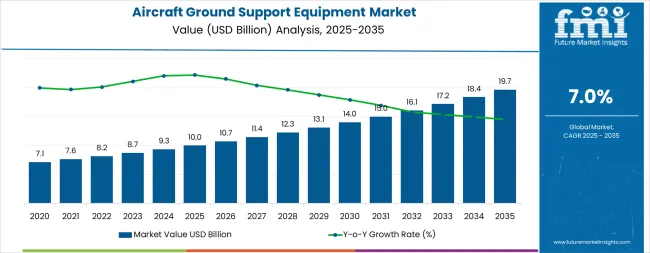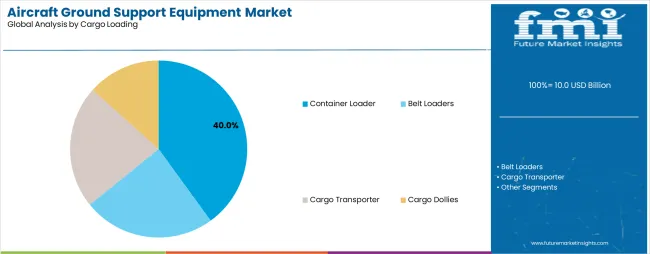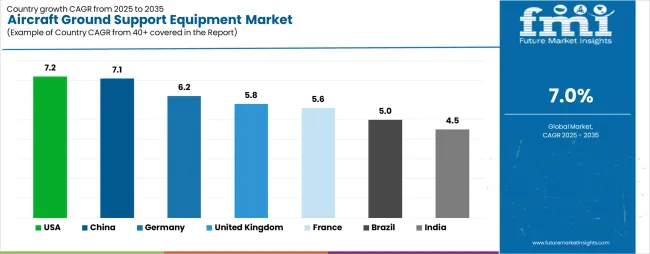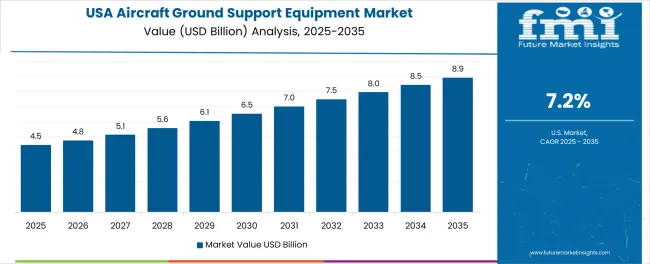The global aircraft ground support equipment market is valued at USD 10 billion in 2025 and is slated to reach USD 19.7 billion by 2035, recording an absolute increase of USD 9.7 billion over the forecast period. This translates into a total growth of 97%, with the market forecast to expand at a compound annual growth rate (CAGR) of 7% between 2025 and 2035.

The overall market size is expected to grow by nearly 2.0X during the same period, supported by increasing global air traffic volumes, growing airport infrastructure modernization, and rising adoption of electric and hybrid GSE solutions across diverse aviation ground operations.
Between 2025 and 2030, the industry is projected to expand from USD 10 billion to USD 14.4 billion, resulting in a value increase of USD 4.4 billion, which represents 45.4% of the total forecast growth for the decade. This phase of development will be shaped by increasing global air traffic recovery, rising airport infrastructure modernization projects, and growing adoption of electric GSE solutions in commercial aviation operations.
Equipment manufacturers are expanding their production capabilities to address the growing demand for efficient ground handling solutions and enhanced operational reliability.
The industry has been positioned as a vital part of global aviation operations, holding nearly 7.8% of the aerospace and defense equipment market, 9.2% of the airport infrastructure market, 6.5% of the aviation services market, 8.1% of the aircraft MRO market, and 12.3% of the ground handling equipment market.
Combined, the market commands around 43.9% of the total share across these parent sectors. The market’s growth is being driven by the expanding air traffic, airport modernization projects, and the emphasis on efficient turnaround time for aircraft operations.
Equipment such as tow tractors, ground power units, and air start systems are being widely adopted to improve operational efficiency and reliability. The industry has become central to ensuring seamless ground operations and improved aircraft uptime across commercial and defense airports globally.
| Metric | Value |
|---|---|
| Estimated Value in (2025E) | USD 10 billion |
| Forecast Value in (2035F) | USD 19.7 billion |
| Forecast CAGR (2025 to 2035) | 7% |
Market expansion is being supported by the increasing global air traffic volumes and the corresponding need for efficient ground handling equipment that can maintain operational reliability and flight schedule adherence while supporting diverse aviation ground operations across various airport environments.
Modern airports and airlines are increasingly focused on implementing equipment solutions that can reduce ground handling time, minimize operational costs, and provide consistent performance in aircraft servicing operations. Aircraft ground support equipment's proven ability to deliver enhanced operational efficiency, reliable ground handling capabilities, and versatile aviation support applications make them essential equipment for contemporary airport operations and aviation ground service solutions.
The growing emphasis on airport modernization and operational efficiency is driving demand for aircraft ground support equipment that can support high-volume air traffic, reduce ground handling delays, and enable efficient aircraft turnaround operations across varying airport configurations.
Airport operators' preference for equipment that combines reliability with operational efficiency and cost-effectiveness is creating opportunities for innovative GSE implementations. The rising influence of environmental regulations and smart airport technologies is also contributing to increased adoption of aircraft ground support equipment that can provide advanced operational control without compromising performance or environmental compliance.
The industry is poised for robust growth and transformation. As airports and airlines across both developed and emerging markets seek ground handling equipment that is efficient, reliable, automated, and environmentally compliant, aircraft ground support systems are gaining prominence not just as operational equipment but as strategic infrastructure for operational efficiency, flight schedule reliability, passenger experience enhancement, and environmental compliance.
Rising air traffic and airport modernization in North America, Europe, and Asia Pacific amplify demand, while manufacturers are picking up on innovations in electric powertrains and automation technologies.
Pathways like electric GSE adoption, automation integration, and smart fleet management promise strong margin uplift, especially in developed markets. Geographic expansion and service diversification will capture volume, particularly where air traffic is growing or airport infrastructure requires modernization. Environmental pressures around emission reduction, noise control, operational efficiency, and carbon neutrality give structural support.
The market is segmented by equipment type, power, application, ownership, and region. By equipment type, the market is divided into passenger services (boarding steps & stairs, airport buses & transport, bed/chair lifts), cargo loading (container loader, belt loaders, cargo transporter, cargo dollies), and airport service (refuelers, tractors, towbarless pushback, ground power units, air start units, lavatory service vehicles, de/anti-icing vehicles, rescue & firefighting equipment, others).
By power, it covers non-electric, electric, and hybrid. By application, it is segmented into commercial and defense. By ownership, it includes owned GSE, leased GSE, and rental GSE. Regionally, the market is divided into North America, Europe, Asia Pacific, Latin America, and Middle East & Africa.

The non-electric equipment segment is projected to account for 62% of the industry in 2025, reaffirming its position as the leading power category. Airport operators and airlines increasingly utilize non-electric GSE for their proven reliability, established fuel infrastructure compatibility, and cost-effectiveness in ground handling operations across passenger services, cargo handling, and airport maintenance applications. Non-electric equipment technology's established operational procedures and consistent performance output directly address the aviation requirements for reliable ground handling and operational efficiency in diverse airport environments.
This power segment forms the foundation of current airport ground operations, as it represents the technology with the greatest operational reliability and established maintenance infrastructure across multiple applications and airport scenarios.
Operator investments in enhanced fuel-powered systems and operational optimization continue to strengthen adoption among airports and airlines. With operators prioritizing operational reliability and equipment availability, non-electric equipment aligns with both operational efficiency objectives and cost management requirements, making them the central component of comprehensive ground support equipment strategies.

Commercial aviation is projected to represent 85% of aircraft ground support equipment demand in 2025, underscoring its critical role as the primary application of GSE for passenger airlines and commercial airport operations. Commercial operators prefer aircraft ground support equipment for their efficiency, reliability, and ability to handle high-volume operations while supporting flight schedules and passenger service requirements. Positioned as essential equipment for modern commercial aviation, GSE offers both operational advantages and service benefits.
The segment is supported by continuous innovation in commercial aviation expansion and the growing availability of specialized equipment configurations that enable efficient ground handling with enhanced operational capabilities. Commercial airlines are investing in fleet optimization to support large-scale operations and passenger service delivery. As air travel demand becomes more prevalent and operational efficiency requirements increase, commercial aviation will continue to dominate the application market while supporting advanced equipment utilization and airport operational strategies.
The industry is advancing steadily due to increasing air traffic volumes and growing adoption of operational efficiency infrastructure that provides enhanced ground handling and flight schedule reliability across diverse aviation applications.
However, the market faces challenges, including high equipment capital costs, specialized maintenance infrastructure requirements, and varying operational requirements across different airport environments. Innovation in electric powertrains and automation technologies continues to influence equipment development and market expansion patterns.
The growing expansion of air travel and airport infrastructure development is enabling equipment manufacturers to develop aircraft ground support systems that provide superior operational efficiency, enhanced ground handling capabilities, and reliable performance in high-volume aviation environments. Advanced GSE systems provide improved operational capacity while allowing more effective aircraft turnaround and consistent service delivery across various applications and airport requirements. Manufacturers are increasingly recognizing the competitive advantages of modern GSE capabilities for operational efficiency and airport productivity positioning.
Modern aircraft ground support equipment manufacturers are incorporating electric powertrains and automated control systems to enhance operational efficiency, reduce emissions, and ensure consistent performance delivery to airport operators. These technologies improve environmental compliance while enabling new applications, including automated cargo handling and smart fleet management solutions. Advanced technology integration also allows manufacturers to support premium equipment positioning and operational optimization beyond traditional ground handling equipment supply.

| Country | CAGR (2025-2035) |
|---|---|
| United States | 7.2% |
| China | 7.1% |
| Germany | 6.2% |
| United Kingdom | 5.8% |
| France | 5.6% |
| Brazil | 5% |
| India | 4.5% |
The industry is experiencing steady growth globally, with the USA leading at a 7.2% CAGR through 2035, driven by extensive airport modernization programs, advanced infrastructure investments, and significant adoption of electric GSE solutions. China follows at 7.1%, supported by massive airport construction projects, rapid aviation expansion, and growing adoption of automated ground handling technologies.
Germany shows growth at 6.2%, emphasizing environmental compliance and advanced manufacturing capabilities. United Kingdom records 5.8%, focusing on airport modernization and post-Brexit operational optimization. France demonstrates 5.6% growth, supported by major airport upgrades and environmental compliance requirements.
Brazil shows 5% growth, driven by airport infrastructure development. India demonstrates 4.5% growth, supported by aviation expansion but constrained by cost sensitivity.
The report covers an in-depth analysis of 40+ countries, the top-performing countries are highlighted below.

Revenue from aircraft ground support equipment in the United States is projected to exhibit exceptional growth with a CAGR of 7.2% through 2035, driven by extensive airport infrastructure modernization programs and rapidly growing adoption of electric GSE solutions supported by environmental regulations and operational efficiency initiatives. The country's comprehensive aviation infrastructure and increasing investment in smart airport technologies are creating substantial demand for advanced ground support equipment solutions. Major airports and airlines are establishing comprehensive GSE fleets to serve both domestic operations and international aviation requirements.
Revenue from aircraft ground support equipment in China is expanding at a CAGR of 7.1%, supported by the country's massive airport construction projects, extensive aviation infrastructure development, and increasing adoption of automated ground handling systems. The country's comprehensive aviation strategy and growing domestic air travel demand are driving sophisticated GSE capabilities. State airports and aviation companies are establishing extensive equipment operations to address the growing demand for efficient ground handling and operational reliability.
Revenue from aircraft ground support equipment in Germany is expanding at a CAGR of 6.2%, supported by the country's strong environmental regulations, advanced manufacturing capabilities, and comprehensive airport modernization programs among aviation operators. The nation's mature aviation sector and increasing emphasis on environmental compliance are driving sophisticated GSE capabilities throughout the equipment market. Leading airports and manufacturers are investing extensively in electric GSE development and technology integration to serve both domestic aviation needs and export markets.
Revenue from aircraft ground support equipment in the United Kingdom is growing at a CAGR of 5.8%, driven by expanding airport modernization programs, increasing environmental compliance requirements, and growing investment in operational efficiency enhancement. The country's established aviation infrastructure and emphasis on post-Brexit operational optimization are supporting demand for advanced GSE technologies across major airport markets. Airport operators and airlines are establishing comprehensive equipment programs to serve both domestic aviation needs and international connectivity requirements.
Revenue from aircraft ground support equipment in France is expanding at a CAGR of 5.6%, supported by the country's focus on major airport infrastructure upgrades, comprehensive environmental compliance programs, and strategic investment in operational efficiency improvement. France's established aviation industry and emphasis on passenger experience enhancement are driving demand for specialized GSE technologies focusing on operational reliability and service quality. Airport operators are investing in comprehensive equipment modernization to serve both domestic aviation requirements and international hub operations.
Revenue from aircraft ground support equipment in Brazil is expanding at a CAGR of 5%, supported by the country's airport infrastructure development programs, growing domestic aviation demand, and increasing investment in operational modernization. Brazil's expanding aviation market and emphasis on infrastructure improvement are driving demand for reliable GSE technologies across major metropolitan airports. Airport operators and airlines are establishing service partnerships to serve both domestic aviation development and international connectivity markets.
Revenue from aircraft ground support equipment in India is expanding at a CAGR of 4.5%, supported by the country's growing aviation sector, increasing domestic air travel demand, and strategic investment in airport infrastructure development. India's expanding aviation market and emphasis on operational efficiency are driving demand for cost-effective GSE technologies across major airport markets. Airlines and airport operators are establishing equipment partnerships to serve both domestic aviation expansion and operational efficiency requirements.

The industry in Europe is projected to grow from USD 2.1 billion in 2025 to USD 3.8 billion by 2035, registering a CAGR of 6.1% over the forecast period. Germany is expected to maintain its leadership position with a 26.8% market share in 2025, increasing to 27.2% by 2035, supported by its advanced aviation infrastructure, comprehensive environmental regulations, and major airport hubs serving European and international markets.
France follows with an 18.9% share in 2025, projected to ease to 18.1% by 2035, driven by major airport modernization programs, environmental compliance initiatives, and established aviation industry capabilities, but facing challenges from competitive pressures and infrastructure investment constraints.
United Kingdom holds a 17.3% share in 2025, expected to decline to 16.9% by 2035, supported by airport modernization requirements and operational optimization initiatives but facing challenges from post-Brexit adjustments and investment uncertainties. Italy commands a 14.2% share in 2025, projected to reach 14.3% by 2035, while Spain accounts for 11.6% in 2025, expected to reach 11.7% by 2035.
The Rest of Europe region, including Nordic countries, Eastern European markets, Belgium, Netherlands, and other European countries, is anticipated to gain momentum, expanding its collective share from 11.2% to 11.9% by 2035, attributed to increasing aviation development across Nordic countries and growing airport modernization across various European markets implementing infrastructure upgrade programs.

The industry is characterized by competition among established aviation equipment manufacturers, specialized GSE technology providers, and integrated ground handling service companies. Companies are investing in advanced electric powertrain research, automation technology development, fleet management optimization, and comprehensive equipment portfolios to deliver efficient, reliable, and environmentally compliant aircraft ground support solutions. Innovation in electric propulsion systems, automated control technologies, and smart fleet integration capabilities is central to strengthening market position and competitive advantage.
Bliss-Fox leads the market with a strong presence, offering specialized aircraft pushback tractors and towing vehicles with a focus on reliability and robust design for airport operations. Tronair (Eagle) provides comprehensive ground support equipment portfolios with an emphasis on innovation, customization, and aftermarket support services. Mallaghan delivers specialized passenger steps, catering trucks, and GSE vehicles with a focus on cost-effective manufacturing and regional adaptability.
Cavotec SA specializes in innovative power and charging systems with emphasis on electrification solutions and operational efficiency. Weihai Guangtai Airport Equipment Co. Ltd. focuses on diverse GSE solutions with regional market leadership and large-scale production capabilities. TLD Group offers comprehensive aircraft ground support equipment with global service networks and fleet management solutions. China International Marine Containers (CIMC) provides cargo loaders and specialized airport vehicles with emphasis on cost leadership and manufacturing scale.
| Items | Values |
|---|---|
| Quantitative Units (2025) | USD 10 billion |
| Equipment Type | Passenger Services (Boarding Steps & Stairs, Airport Buses & Transport, Bed/Chair Lifts), Cargo Loading (Container Loader, Belt Loaders, Cargo Transporter, Cargo Dollies), Airport Service (Refuelers, Tractors, Towbarless Pushback, Ground Power Units, Air Start Units, Lavatory Service Vehicles, De/Anti-Icing Vehicles, Rescue & Firefighting Equipment, Others) |
| Power | Non-Electric, Electric, Hybrid |
| Application | Commercial, Defense |
| Ownership | Owned GSE, Leased GSE, Rental GSE |
| Regions Covered | North America, Europe, Asia Pacific, Latin America, Middle East & Africa |
| Countries Covered | United States, Canada, Germany, United Kingdom, France, China, Japan, Brazil, India and 40+ countries |
| Key Companies Profiled | Bliss-Fox, Tronair (Eagle), Mallaghan, Cavotec SA, Weihai Guangtai Airport Equipment Co. Ltd., TLD Group, and China International Marine Containers (CIMC) |
| Additional Attributes | Equipment sales by type and power category, regional demand trends, competitive landscape, technological advancements in electric systems, automation development, fleet management innovation, and operational efficiency optimization |
The global aircraft ground support equipment market is estimated to be valued at USD 10.0 billion in 2025.
The market size for the aircraft ground support equipment market is projected to reach USD 19.7 billion by 2035.
The aircraft ground support equipment market is expected to grow at a 7.0% CAGR between 2025 and 2035.
The key product types in aircraft ground support equipment market are airport buses & transport, boarding steps & stairs and bed/chair lifts.
In terms of cargo loading, container loader segment to command 40.0% share in the aircraft ground support equipment market in 2025.






Our Research Products

The "Full Research Suite" delivers actionable market intel, deep dives on markets or technologies, so clients act faster, cut risk, and unlock growth.

The Leaderboard benchmarks and ranks top vendors, classifying them as Established Leaders, Leading Challengers, or Disruptors & Challengers.

Locates where complements amplify value and substitutes erode it, forecasting net impact by horizon

We deliver granular, decision-grade intel: market sizing, 5-year forecasts, pricing, adoption, usage, revenue, and operational KPIs—plus competitor tracking, regulation, and value chains—across 60 countries broadly.

Spot the shifts before they hit your P&L. We track inflection points, adoption curves, pricing moves, and ecosystem plays to show where demand is heading, why it is changing, and what to do next across high-growth markets and disruptive tech

Real-time reads of user behavior. We track shifting priorities, perceptions of today’s and next-gen services, and provider experience, then pace how fast tech moves from trial to adoption, blending buyer, consumer, and channel inputs with social signals (#WhySwitch, #UX).

Partner with our analyst team to build a custom report designed around your business priorities. From analysing market trends to assessing competitors or crafting bespoke datasets, we tailor insights to your needs.
Supplier Intelligence
Discovery & Profiling
Capacity & Footprint
Performance & Risk
Compliance & Governance
Commercial Readiness
Who Supplies Whom
Scorecards & Shortlists
Playbooks & Docs
Category Intelligence
Definition & Scope
Demand & Use Cases
Cost Drivers
Market Structure
Supply Chain Map
Trade & Policy
Operating Norms
Deliverables
Buyer Intelligence
Account Basics
Spend & Scope
Procurement Model
Vendor Requirements
Terms & Policies
Entry Strategy
Pain Points & Triggers
Outputs
Pricing Analysis
Benchmarks
Trends
Should-Cost
Indexation
Landed Cost
Commercial Terms
Deliverables
Brand Analysis
Positioning & Value Prop
Share & Presence
Customer Evidence
Go-to-Market
Digital & Reputation
Compliance & Trust
KPIs & Gaps
Outputs
Full Research Suite comprises of:
Market outlook & trends analysis
Interviews & case studies
Strategic recommendations
Vendor profiles & capabilities analysis
5-year forecasts
8 regions and 60+ country-level data splits
Market segment data splits
12 months of continuous data updates
DELIVERED AS:
PDF EXCEL ONLINE
Korea Aircraft Ground Support Equipment Market – Trends & Forecast 2025-2035
Japan Aircraft Ground Support Equipment Market Analysis & Forecast by Equipment, Ownership, Power, Application, and Region Through 2025 to 2035
Western Europe Aircraft Ground Support Equipment Market Analysis by Equipment, Power, Ownership, Application and Region: Forecast for 2025 to 2035
Aircraft Cabin Environment Sensor Market Forecast and Outlook 2025 to 2035
Aircraft Flight Control System Market Size and Share Forecast Outlook 2025 to 2035
Aircraft Electric Motor Market Forecast Outlook 2025 to 2035
Aircraft Cooling Turbines Market Size and Share Forecast Outlook 2025 to 2035
Aircraft Smoke Detection and Fire Extinguishing System Market Size and Share Forecast Outlook 2025 to 2035
Aircraft Hose Fittings Market Size and Share Forecast Outlook 2025 to 2035
Aircraft Cabin Interior Market Size and Share Forecast Outlook 2025 to 2035
Aircraft Galley Systems Market Size and Share Forecast Outlook 2025 to 2035
Aircraft Interior Lighting Market Size and Share Forecast Outlook 2025 to 2035
Aircraft Battery Market Size and Share Forecast Outlook 2025 to 2035
Aircraft Floor Panels Market Size and Share Forecast Outlook 2025 to 2035
Aircraft Fuel Systems Market Size and Share Forecast Outlook 2025 to 2035
Aircraft Lubricant Market Size and Share Forecast Outlook 2025 to 2035
Aircraft Seat Market Size and Share Forecast Outlook 2025 to 2035
Aircraft Maintenance, Repair and Overhaul Market Size and Share Forecast Outlook 2025 to 2035
Aircraft Actuators Market Size and Share Forecast Outlook 2025 to 2035
Aircraft Elevator Market Size and Share Forecast Outlook 2025 to 2035

Thank you!
You will receive an email from our Business Development Manager. Please be sure to check your SPAM/JUNK folder too.
Chat With
MaRIA